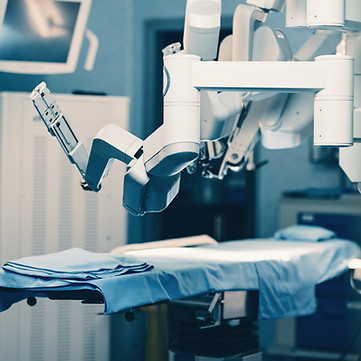

Thoracic surgery

Minimally invasive thoracic surgery thanks to the da Vinci robot
The advantages of thoracic surgery assisted with the da Vinci robot are impressive. Thanks to this minimally invasive approach, interventions that until recently required long hospitalizations, are now performed almost outpatient, with fewer complications and virtually no pain.
The Da Vinci Robot allows surgeons to access thoracic organs through small incisions through which the high-resolution 3D camera and the robotic arms are placed. Thanks to this new technology, complex surgical procedures can be performed reducing the post-operative pain, complications and hospital stay and finally achieving an optimal recovery, allowing patients to be back in their normal life faster than ever before.

What is thoracic robotic surgery?
Da Vinci robotic surgery is a state-of-the-art surgical procedure, in which the conventional laparoscopic technique is combined with high-precision robotic technology thanks to 4 robotic arms that are comfortably commanded by the surgeon from the surgical console and also using an immersive 3D high definition image. The robotic arms have a joint that grants the same movement capacity as the human wrist, so the surgeon can perform complex procedures with precision and safety.
Thanks to the improved vision, the versatility of the instruments, the elimination of the physiological tremor and the comfortable ergonomic position of the console that prevents fatigue, complex procedures such as resection of pulmonary or mediastinal tumors are minimally invasive performed through small incisions in the chest wall. This approach allows us to obtain optimal results and at the same time, an incredibly fast recovery since large incisions that are usually made in conventional surgery are not required.
Thanks to robotic surgery, complex surgeries can now be performed in a minimally invasive manner, which translates into less chest trauma, less pain, fewer complications, and less hospital stay.

Robotic thoracic surgery advantages

Thanks to da Vinci robotic surgery, significant benefits are achieved, including:
-
Shorter postoperative stay
-
Less blood loss
-
Lower rate of postoperative complications
-
Shorter pleural drainage time
-
Less post-operative pain and less need for analgesics
-
Early return to usual activity
-
Better vision and dissection of the tissue so that locally advanced tumors are removed more easily
-
Similar oncological efficacy and better results in the treatment of Myasthenia Gravis
-
Enhanced lymph node removal

Is robotic surgery right for me?
Probably yes. The use of the da Vinci robot extends to many of the surgical interventions performed by thoracic surgeons, including surgery for the treatment of lung tumors, thymoma and Myasthenia Gravis, among others.
Robotic lung tumor resection
The robotic approach applied to the treatment of lung tumors (lobectomy) allows to improve oncological results (since it improves the radicality and quality of lymphadenectomy) and improves post-operative parameters such as hospital stay, complication rate, thoracic drainage time and need for analgesics compared with open and endoscopic technique.
Robot-assisted Pulmonary Lobectomy provides high-precision dissection, using the most modern instruments available. The da Vinci Surgical Robot allows surgeons to operate through millimeter incisions, maximizing the mobility of surgical instruments and providing a high-resolution three-dimensional view.
Thymus surgery (thymectomy)
The removal of the thymus (a gland located in the thorax, in front of the heart) is recommended for the treatment of tumors (thymomas) or other pathologies such as Myasthenia Gravis. This intervention is called thymectomy and was performed classically opening the sternum, which is sectioned longitudinally and separated (sternotomy). At the end of the surgery, the sternum should be closed using a metal suture.
In contrast, a sternotomy is not required in robotic thymectomy, because the entire procedure is performed in a minimally invasive manner, which allows better results (higher complete remission rate in Myasthenia Gravis), fewer complications, less post-operative pain, and shorter hospital stay, enabling patients to return faster to their normal life.
Meet your surgeon

Dr. Pau Rodríguez Taboada
Dr. Pau Rodríguez is a specialist in thoracic surgery, minimally invasive surgery and da Vinci robotic surgery.
He has a PhD from the University of Barcelona and is currently an associate professor of anatomy at the Rovira i Virgili University.
It carries out its assistance activity at the Hospital Universitari de Bellvitge and at the Hospital Joan XXIII of Tarragona, being in both centers the reference surgeon in robotic surgery.